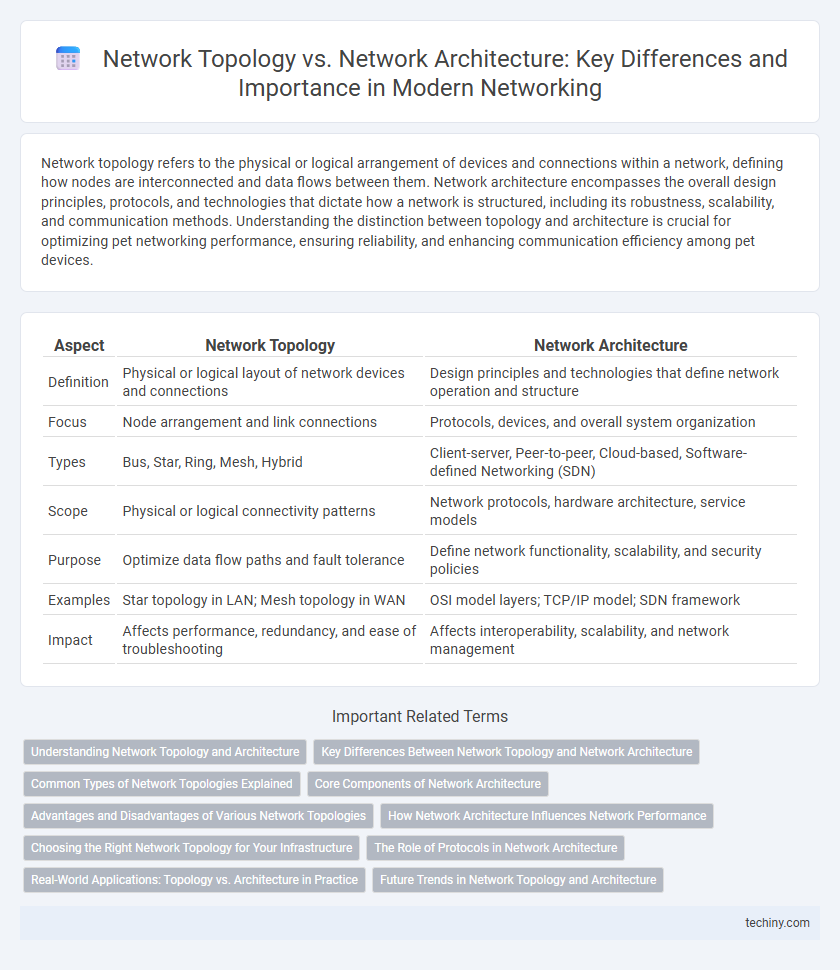Network topology refers to the physical or logical arrangement of devices and connections within a network, defining how nodes are interconnected and data flows between them. Network architecture encompasses the overall design principles, protocols, and technologies that dictate how a network is structured, including its robustness, scalability, and communication methods. Understanding the distinction between topology and architecture is crucial for optimizing pet networking performance, ensuring reliability, and enhancing communication efficiency among pet devices.
Table of Comparison
| Aspect | Network Topology | Network Architecture |
|---|---|---|
| Definition | Physical or logical layout of network devices and connections | Design principles and technologies that define network operation and structure |
| Focus | Node arrangement and link connections | Protocols, devices, and overall system organization |
| Types | Bus, Star, Ring, Mesh, Hybrid | Client-server, Peer-to-peer, Cloud-based, Software-defined Networking (SDN) |
| Scope | Physical or logical connectivity patterns | Network protocols, hardware architecture, service models |
| Purpose | Optimize data flow paths and fault tolerance | Define network functionality, scalability, and security policies |
| Examples | Star topology in LAN; Mesh topology in WAN | OSI model layers; TCP/IP model; SDN framework |
| Impact | Affects performance, redundancy, and ease of troubleshooting | Affects interoperability, scalability, and network management |
Understanding Network Topology and Architecture
Network topology defines the physical or logical layout of devices and connections in a network, such as star, mesh, or ring configurations, which impact data flow and fault tolerance. Network architecture encompasses the overall design principles, protocols, and technologies that dictate how network components interact, ensuring scalability, security, and performance. Understanding the distinction between topology and architecture is crucial for optimizing network efficiency and guiding infrastructure development.
Key Differences Between Network Topology and Network Architecture
Network topology defines the physical or logical arrangement of devices and connections within a network, such as star, ring, or mesh configurations, emphasizing spatial relationships. Network architecture encompasses the overall design and framework of a network, including protocols, hardware, software, and communication standards that govern data flow and system behavior. Key differences lie in topology's focus on layout and connection patterns, whereas architecture covers structural design, functional components, and network operation principles.
Common Types of Network Topologies Explained
Common types of network topologies include bus, star, ring, mesh, and tree, each defining how devices connect and communicate within a network. Bus topology uses a single central cable to which all devices attach, ideal for small networks but prone to congestion. Star topology features a central hub connecting all nodes, offering better fault tolerance, while mesh topology provides multiple pathways for data, enhancing reliability and redundancy in large, complex networks.
Core Components of Network Architecture
Network architecture encompasses the core components such as routers, switches, firewalls, and access points that define the framework and functionality of a network. Network topology refers to the physical or logical arrangement of these components, including star, mesh, and bus configurations that influence data flow and redundancy. Understanding the interaction between network architecture's core devices and the chosen topology is crucial for optimizing performance, scalability, and security in a networking environment.
Advantages and Disadvantages of Various Network Topologies
Star topology offers centralized management and ease of fault isolation, but it depends heavily on a central hub, creating a single point of failure. Mesh topology provides high redundancy and fault tolerance through multiple interconnected nodes, though it requires complex configuration and higher costs. Ring topology enables orderly data transmission with predictable latency but suffers from network disruption if any single node fails without proper redundancy mechanisms.
How Network Architecture Influences Network Performance
Network architecture defines the overall design and framework of a network, including protocols, hardware, and software integration, which directly impacts network performance by optimizing data flow and resource allocation. A well-designed architecture reduces latency and enhances bandwidth efficiency, supporting scalable and reliable communication across nodes. Network topology, while describing the physical or logical arrangement of devices, depends on architecture decisions to ensure effective connectivity and performance management.
Choosing the Right Network Topology for Your Infrastructure
Selecting the appropriate network topology such as star, mesh, or ring is crucial for optimizing performance, scalability, and fault tolerance in your infrastructure. Network topology defines the physical or logical arrangement of devices, directly impacting data flow efficiency and maintenance costs. Understanding your organization's specific traffic patterns, hardware capabilities, and redundancy requirements ensures a topology choice that aligns with overall network architecture goals.
The Role of Protocols in Network Architecture
Protocols define the communication rules and standards that enable devices within a network architecture to interact efficiently, ensuring data integrity, security, and proper routing. Network architecture leverages protocols like TCP/IP, HTTP, and FTP to establish structured layers that manage data flow, while topology refers to the physical or logical arrangement of network devices. Understanding protocols is crucial for designing scalable and reliable network architectures that support diverse applications and services across various topologies.
Real-World Applications: Topology vs. Architecture in Practice
Network topology defines the physical and logical arrangement of devices and connections within a network, influencing data flow efficiency and fault tolerance. Network architecture encompasses the overall design principles, protocols, and functional components shaping the network's performance and scalability. In real-world applications, topology determines the layout for specific tasks such as star or mesh for resilience, while architecture guides implementation strategies like client-server or peer-to-peer models to meet organizational needs.
Future Trends in Network Topology and Architecture
Future trends in network topology emphasize the growth of hybrid and mesh topologies to enhance scalability and reliability in complex environments. Network architecture is increasingly adopting software-defined networking (SDN) and intent-based networking (IBN) to enable greater automation, flexibility, and real-time adaptability. Integration of AI-driven analytics and edge computing is driving the evolution of network design, optimizing performance and security in next-generation infrastructures.
Network Topology vs Network Architecture Infographic

 techiny.com
techiny.com